If can’t find spelt four in your local grocery store, by all means, substitute with whole wheat flour in these recipes! Spelt flour is an ancient grain that has a beautiful earthy and clean aroma and flavor.
And you can absolutely use nothing but all purpose flour or bread flour if that’s what you have on-hand.
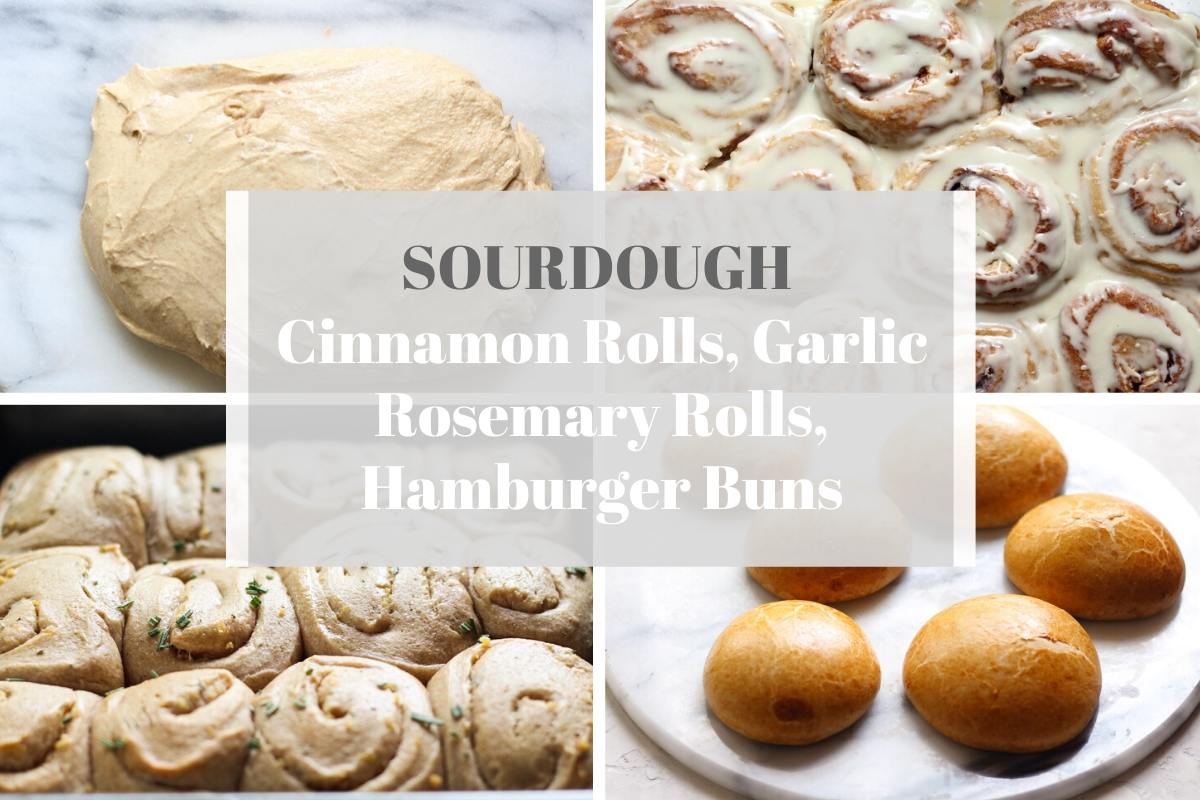
One of the most common requests I get is for a single dough that can be used to make several different recipes. Brioche dough is extremely versatile because it’s soft, pillowy, and buttery, and is perfect for savory or sweet applications.
I published the sourdough spelt brioche dough recipe with the intention of transforming it into several delicious concoctions. Even though the original recipe can be found on that post, I’m posting three separate recipe cards on this post since there are extra ingredients added to these recipes with slight variations on how they are shaped.
These 3 recipes are not the only wonderful things you can do with brioche, so let your imagination run wild!
So let’s bake, shall we?
First up…
SOURDOUGH CINNAMON ROLLS
Soft, pillowy, luscious sourdough cinnamon rolls. Even though they are sourdough, it’s a very subtle flavor, and not super sour. Just because a recipe has a sourdough culture in it, doesn’t necessarily mean the sourdough flavor has to be prominent.
As with all variations of the sourdough spelt brioche recipe, start by making the dough and let ferment all day or overnight at room temperature. Remember, a sourdough starter ferments dough much more slowly than dry yeast, adding much more flavor and helping with digestibility (among other things).
Although dry yeast ferments dough faster, I find it much easier to make dough at night (with a sourdough starter) and then finish it in the morning, instead of having to get up at 5am and spend 2 hours fermenting the dough with dry yeast, shaping, proofing, baking all at once, so it can be ready for breakfast time.
Basically, you are having to spend a few hours in a row babying a dough when you are using dry yeast because it will ferment out of control if you need to leave it alone for a few hours and actually be able to go live your life outside of baking.
After the dough has fermented overnight, simply flatten out to a large 13 x 13-inch square, brush with melted butter and sprinkle with a combo of brown sugar and cinnamon. Roll semi-tightly then cut into 11 or 12 pieces. Place in a greased casserole dish, proof for about 45 minutes, then bake.
BEFORE PROOFING
AFTER PROOFING
Although there doesn’t look like much difference in size before and after proofing , the gaps between the cinnamon rolls will be pretty much filled and it will be puffier, but by only about 30% more. It will continue to rise and puff up in the oven.
Now glaze those babies with a combo of confectioners sugar, milk, and vanilla.
Pin this post for cinnamon rolls on Pinterest
Sourdough Spelt Brioche Cinnamon Rolls
Ingredients
- 1 1/2 cups plus 1 Tbsp. Spelt Flour or Whole Wheat Flour 250 grams
- 1 1/2 cups plus 1 Tbsp. All Purpose Flour 250 grams
- 3/4 cup plus 1 Tbsp. Milk, cold 200 grams
- 2 eggs, cold about 100 grams
- 1 tsp salt 10 grams
- 1/4 cup Ripe Sourdough Starter about 78 grams
- 1/4 cup Sugar 50 grams
- 11 Tbsp Unsalted Butter, slightly softened 150 grams
For the Filling
- 3/4 cup Brown Sugar
- 2 Tbsp Butter, melted
- 2 Tbsp Cinnamon
For the Glaze
- 1 cup powdered sugar
- 3 Tbsp Milk
- 1/4 tsp Vanilla
Instructions
Mixing the Dough
- Mix all ingredients together except for the butter in a stand mixer. Mix on 1st speed for about 5 minutes. Turn the mixer on 2nd speed and mix until the dough comes together and pulls away from the side of the bowl. Turn the mixer back to 1st speed and add butter to incorporate. Turn back to 2nd speed and mix until the dough pulls away from the side of the bowl and is shiny and elastic.
Fermenting the Dough
- Form the ball into a round shape and cover with plastic wrap. Let ferment all day or overnight at room temperature (about 8-10 hours), so it doubles in size. A sourdough culture ferments dough much more slowly than dry yeast, so you won't have to worry about it over-fermenting.
Shaping and Proofing the Dough
- Flatten the dough out to a 13 x 13 inch square on a lightly floured surface. Melt the 2 Tbsp butter and brush the surface of the dough. Mix the cinnamon and brown sugar together and sprinkle over the surface of the dough.
- Roll the dough semi-tightly into a log and cut into 8 slices for larger cinnamon rolls or 10-11 slices for medium-sized ones. Place them in a buttered casserole dish and cover.
- Turn the oven on to 350 degrees and set the casserole dish on top of the stove so it has a warm place to proof. It will take about 40-45 minutes to proof, but it varies on the temperature of your house. The rolls will puff up about 30% and the spaces between them will be filled.
Baking the Cinnamon Rolls
- Bake in a 350 degree oven for about 40-45 minutes. You can puncture the inside of the dough with a knife to see if the dough is cooked through.
- Mix the powdered sugar, 3 Tbsp milk, and vanilla together with a fork or whisk. Pour over the hot cinnamon rolls. Serve immediately.
Video
Notes
Flour Substitutions
You can use only all-purpose flour if that's all you have, or all bread flour too.
SOURDOUGH GARLIC ROSEMARY ROLLS
Garlic, butter, rosemary. These rolls are PERFECT for the holidays or a family gathering. Make a pan of these and watch them disappear!
The process is the same except you add rosemary to the dough when mixing. Ferment all day or overnight, brush with butter and sprinkle lots of chopped garlic on the surface, roll, cut, proof, then bake.
MWAAHHH!
BEFORE PROOFING
AFTER PROOFING
Again, the dough is proofed when its risen about 30%, but will rise even more in the oven.
Sourdough Spelt Garlic Rosemary Brioche Rolls
Ingredients
For the Dough
- 1 1/2 cups plus 1 Tbsp Spelt Flour or Whole Wheat Flour 250 grams
- 1 1/2 cups plus 1 Tbsp All Purpose Flour 250 grams
- 3/4 cups plus 1 Tbsp Milk, cold 200 grams
- 2 Eggs about 100 grams
- 1 tsp Salt 10 grams
- 1/4 cup Ripe Sourdough Starter 78 grams
- 1/4 cup Sugar 50 grams
- 11 Tbsp Butter, slightly softened 150 grams
- 1 Tbsp Fresh Rosemary, finely chopped
For the Garlic Filling
- 3-5 Garlic Cloves, finely chopped use enough to evenly cover the inside of the roll
- 2 Tbsp Butter, melted
Optional Topping
- 2 Tbsp Everything Bagel Seasoning blend
Instructions
- Mix all ingredients for the dough together except for the butter in a stand mixer. Mix on 1st speed for about 5 minutes. Turn the mixer on 2nd speed and mix until the dough comes together and pulls away from the side of the bowl. Turn the mixer back to 1st speed and add butter to incorporate. Turn back to 2nd speed and mix until the dough pulls away from the side of the bowl and is shiny and elastic.
Fermenting the Dough
- Form the ball into a round shape and cover with plastic wrap. Let ferment all day or overnight at room temperature (about 8-10 hours), so it doubles in size. A sourdough culture ferments dough much more slowly than dry yeast, so you won't have to worry about it over-fermenting.
Shaping and Proofing the Dough
- Take the dough out of the bowl and gently flatten to a 10 x 12 rectangle. Brush the 2 Tbsp of melted butter over the top to cover. You may not need all of it. Sprinkle the garlic evenly all over the top. Roll the dough semi-tightly into a log shape. Cut the dough into 12 pieces and place them in a square pan.
- Cover the pan with plastic wrap and let proof. The best way to proof it is to put it on top of the oven with the oven turned on to create a warm space. It should take about 45 minutes to proof. It will have increased in size by about 30%.
Baking the Rolls
- Preheat the oven to 375 degrees. Bake for about 20-25 minutes. You can check for doneness by piercing the inside with a knife to see if it comes out clean.
- To serve, brush a bit more butter on top while they are warm.
Notes
Flour Substitutions
You can use only all-purpose flour if that's all you have, or all bread flour too.Last, but certainly not least….
SOURDOUGH HAMBURGER BUNS
The BEST burgers have to have perfect soft and buttery buns. Brioche hamburger buns lend the perfect soft texture when you bite into your burger.
I really don’t think there needs to much more explanation for the perfection of these brioche buns. So let’s get going!
The shaping of the buns is the only step that can be a bit tricky. It’s actually quite simple, but you want to make sure that when you roll them into balls there is no flour on your work surface so the buns will seal on the bottom.
You can flour your hands to keep them from sticking to the dough, just keep it off of the work surface.
BEFORE PROOFING
AFTER PROOFING
When you proof the buns, they will spread a bit instead of rising because the sourdough starter creates a softer gluten structure. They will puff up in the oven however.
After proofing, egg wash the tops before baking to create a beautiful shine on the buns.
Sourdough Spelt Brioche Hamburger Buns
Ingredients
For the Dough
- 1 1/2 cups plus 1 Tbsp Spelt Flour or Whole Wheat Flour 250 grams
- 1 1/2 cups plus 1 Tbsp All Purpose Flour 250 grams
- 3/4 cup plus 1 Tbsp Milk, cold 200 grams
- 2 Eggs about 100 grams
- 1 tsp Salt 10 grams
- 1/4 cup Ripe Sourdough Starter 78 grams
- 1/4 cup Sugar 50 grams
- 11 Tbsp Butter, slightly softened 150 grams
For the Egg Wash
- 1 Egg, beaten
- 1 Tbsp Milk or heavy cream
Instructions
For the Dough
- Mix all ingredients for the dough together except for the butter in a stand mixer. Mix on 1st speed for about 5 minutes. Turn the mixer on 2nd speed and mix until the dough comes together and pulls away from the side of the bowl. Turn the mixer back to 1st speed and add butter to incorporate. Turn back to 2nd speed and mix until the dough pulls away from the side of the bowl and is shiny and elastic.
Fermenting the Dough
- Form the ball into a round shape and cover with plastic wrap. Let ferment all day or overnight at room temperature (about 8-10 hours), so it doubles in size. A sourdough culture ferments dough much more slowly than dry yeast, so you won't have to worry about it over-fermenting.
Shaping and Proofing the Dough
- Take the dough out onto your work surface and pat into a rectangle. Cut into 8 equal-sized pieces. Flour your hands, but keep the work surface clean. Fold each piece of the dough toward the bottom to meet in the center. With the palm of your hand cupped, take the dough seam-side-down and begin to roll the dough into a ball so that it seals on the bottom. Use your hand as a guide, but don't press down on it so it forms a ball. When it's a firm ball, place on a parchment-lined sheet pan. Place up to six buns on one regularly-sized sheet pan.
- Egg wash the tops of the buns and cover the pans with plastic wrap.
- Proof the buns on top of the oven with the oven turned on so that it creates a warm space for the buns. Proof for about 45 minutes or until the buns have spread out a bit.
- Egg wash the tops of the buns a second time before baking.
- Bake in a 350 degree oven for about 30 minutes until the tops are golden brown. If you have two sheet pans, you can place one sheet pan in the fridge to slow down fermentation while the other pan is baking. Just make sure the buns remained covered in the fridge.
Notes
Flour Substitutions
You can use only all-purpose flour if that's all you have, or all bread flour too.Well, if you’ve stuck around until the end, I hope you feel inspired to make this sourdough brioche dough and transform into luscious, buttery delights! If you have any questions, please don’t hesitate to comment below.
Bon Appetit Ya’ll,
Leslie O.

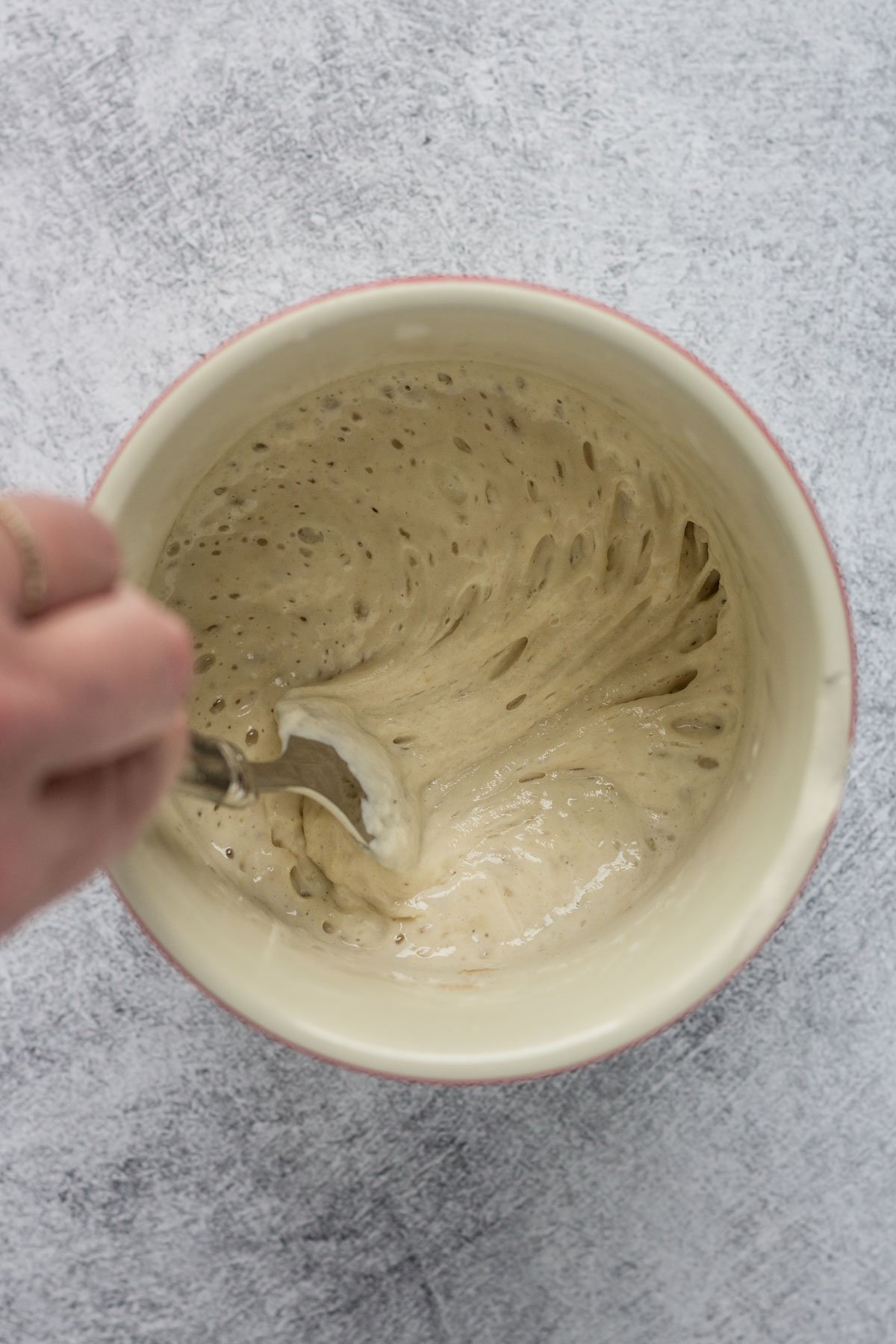
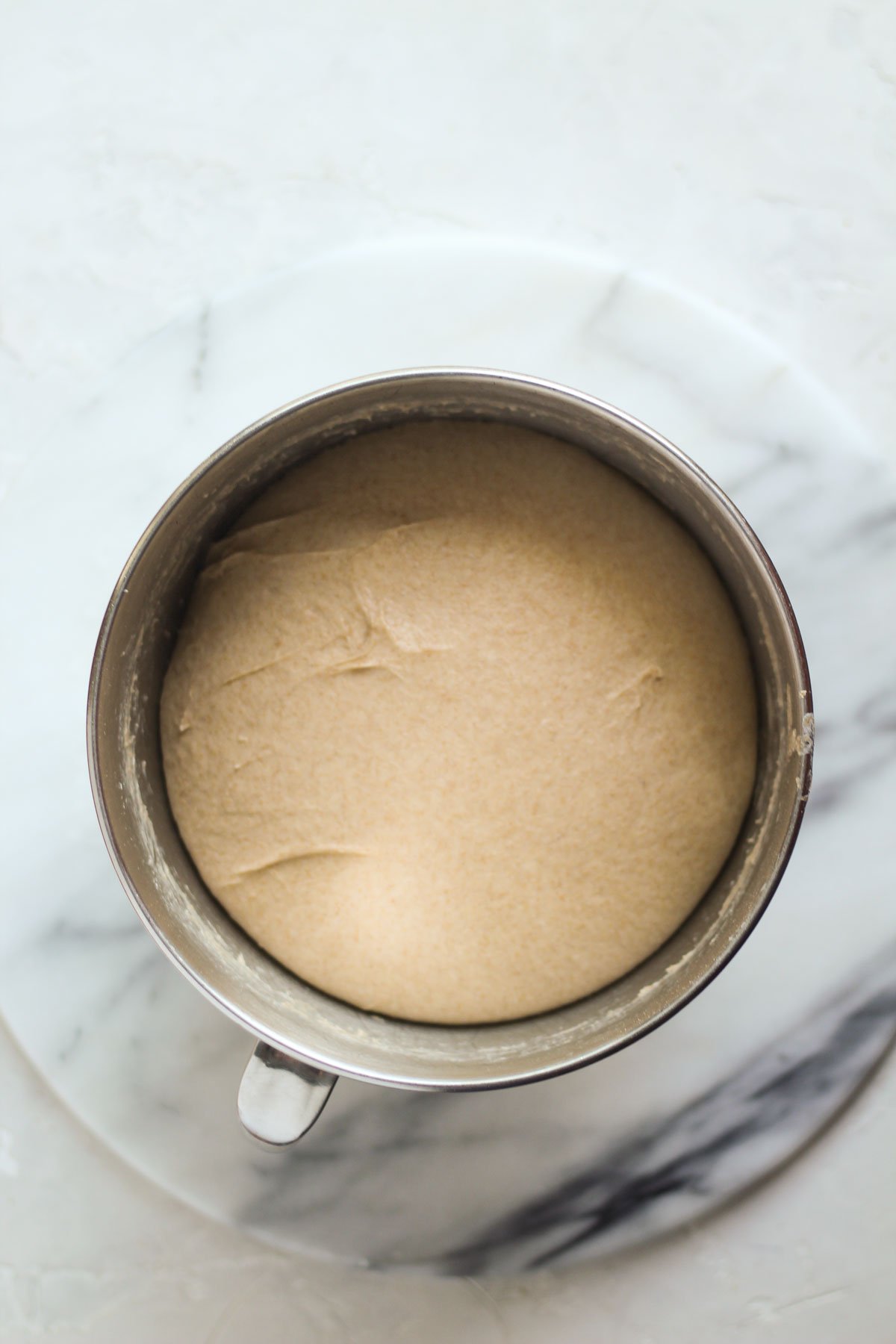
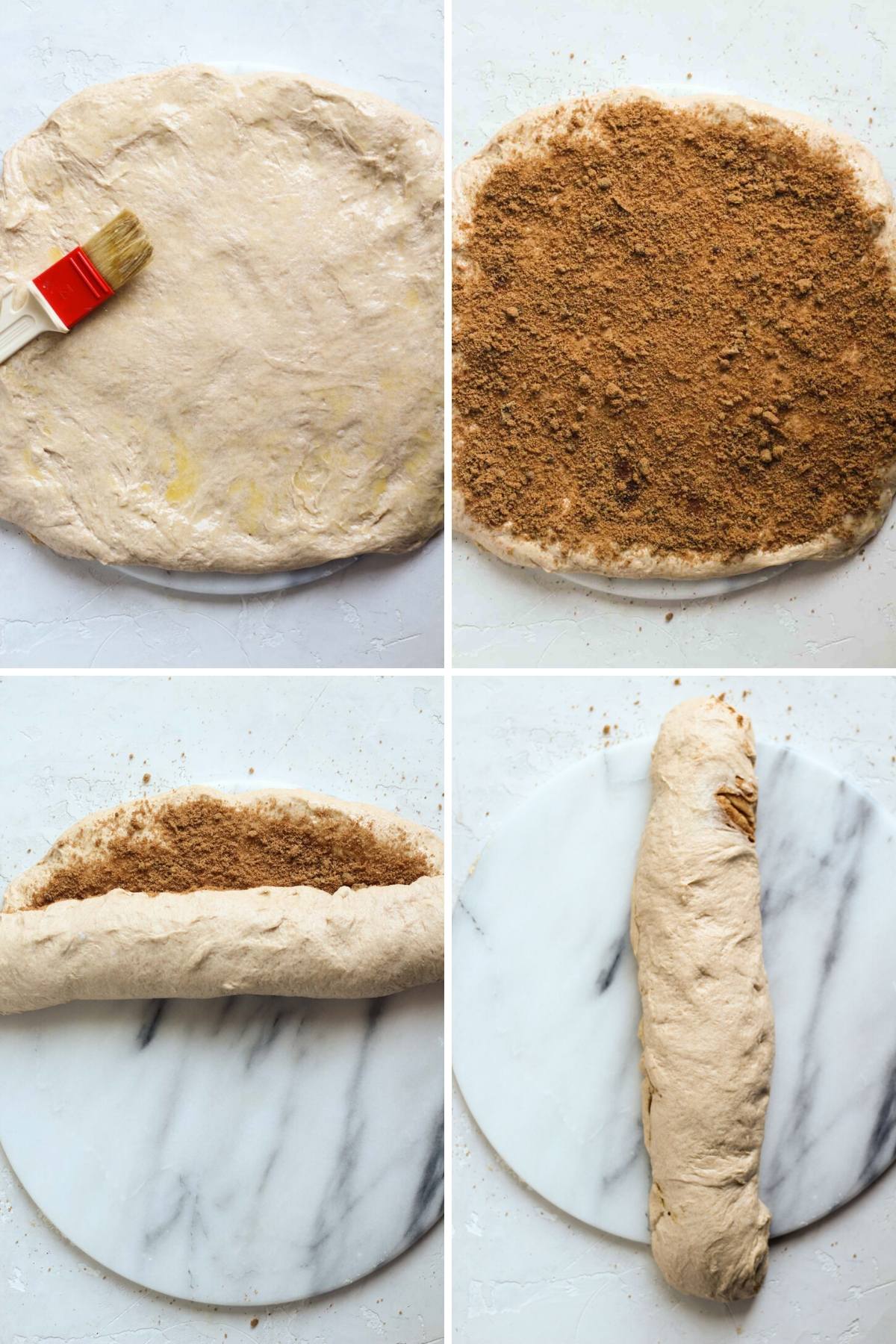
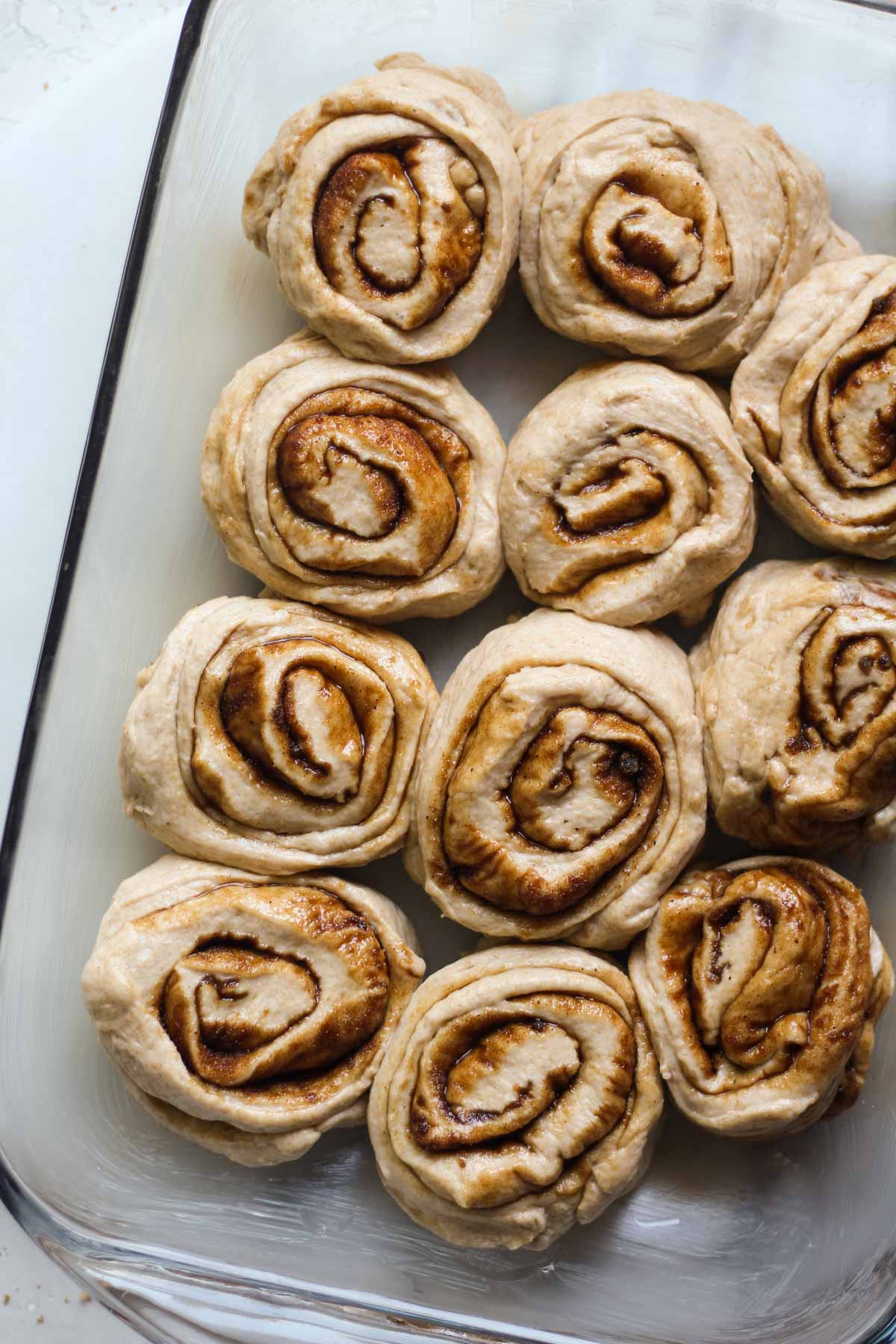
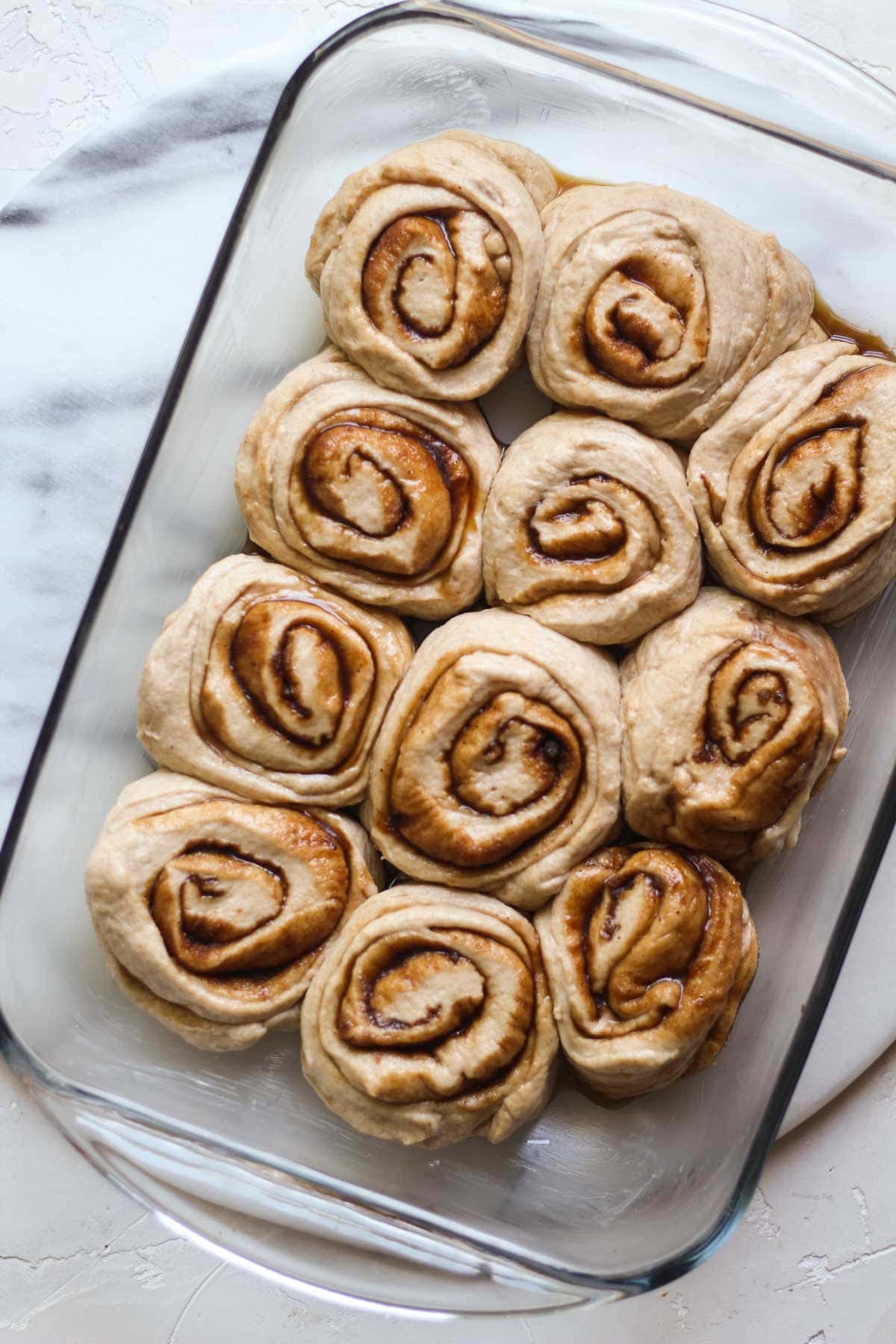
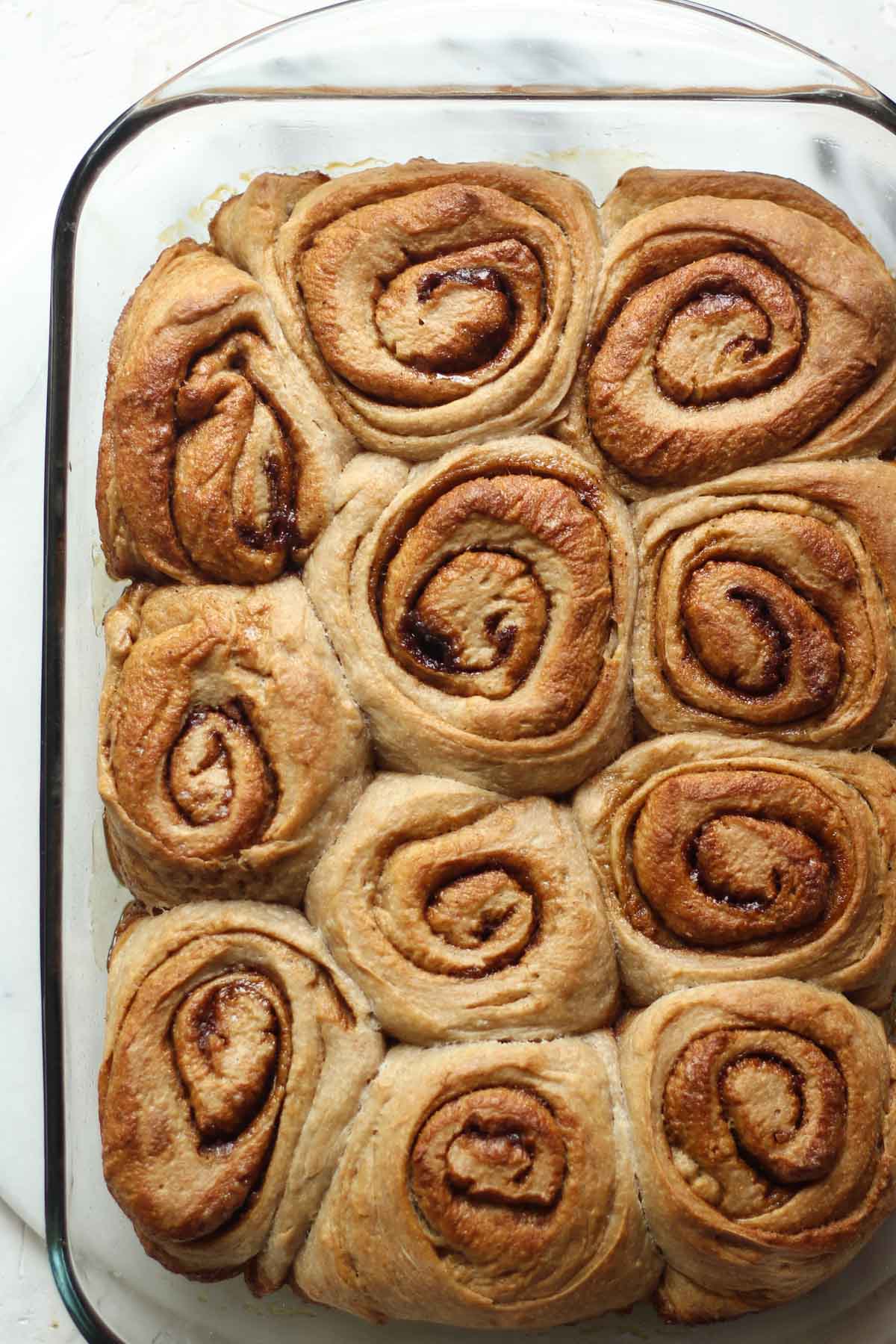
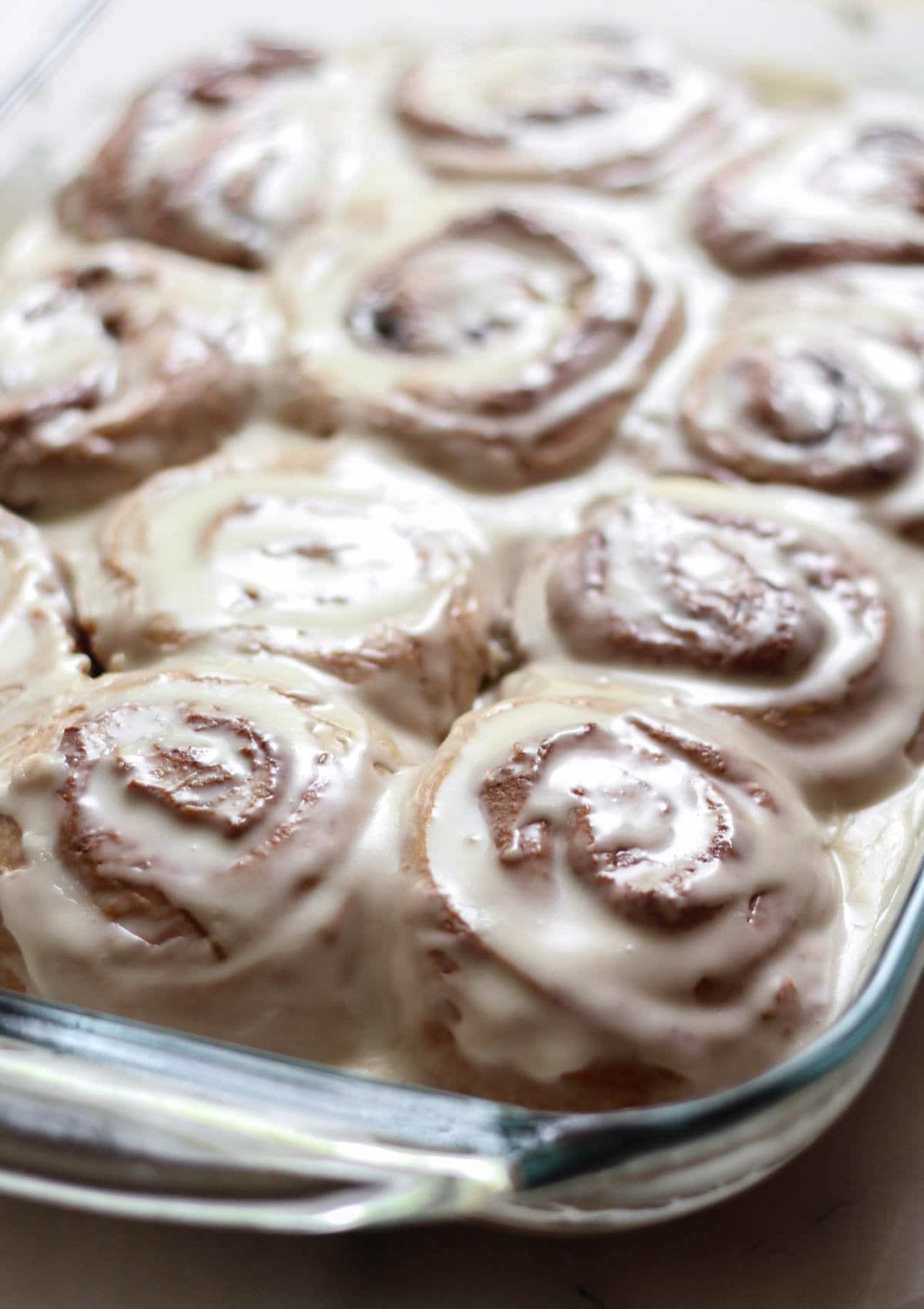

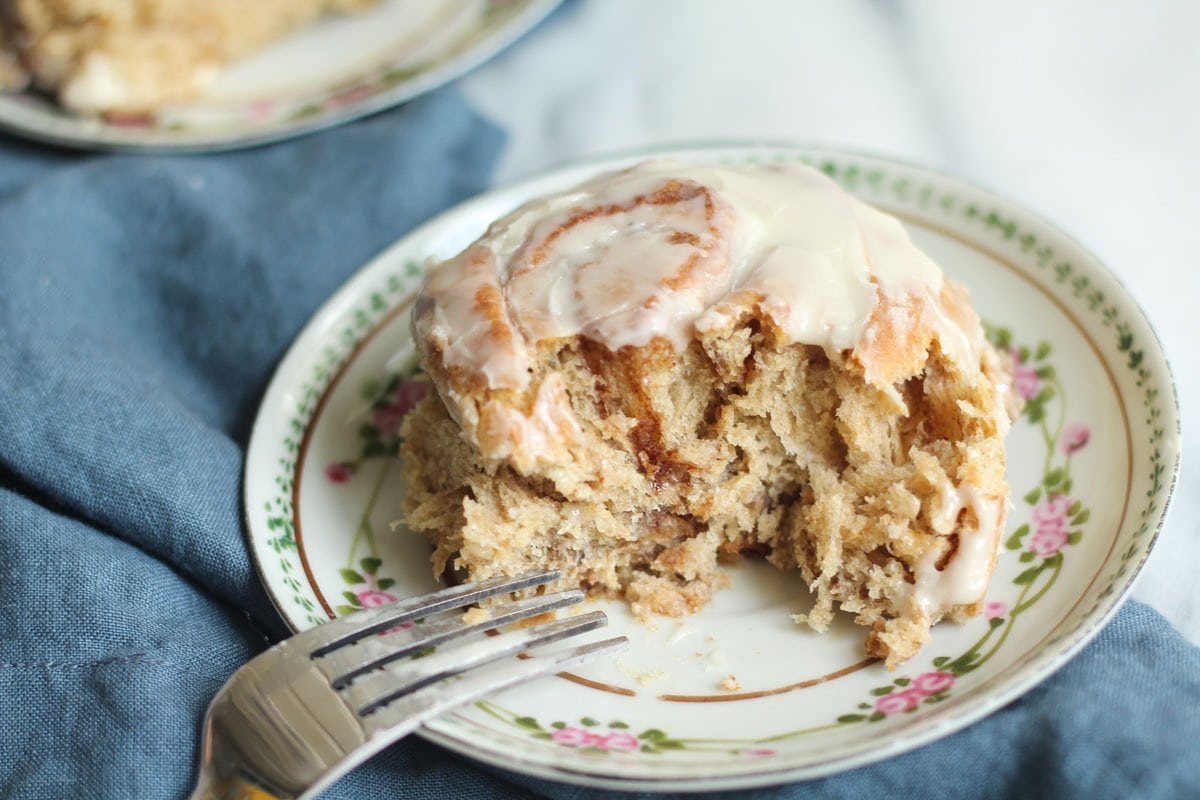
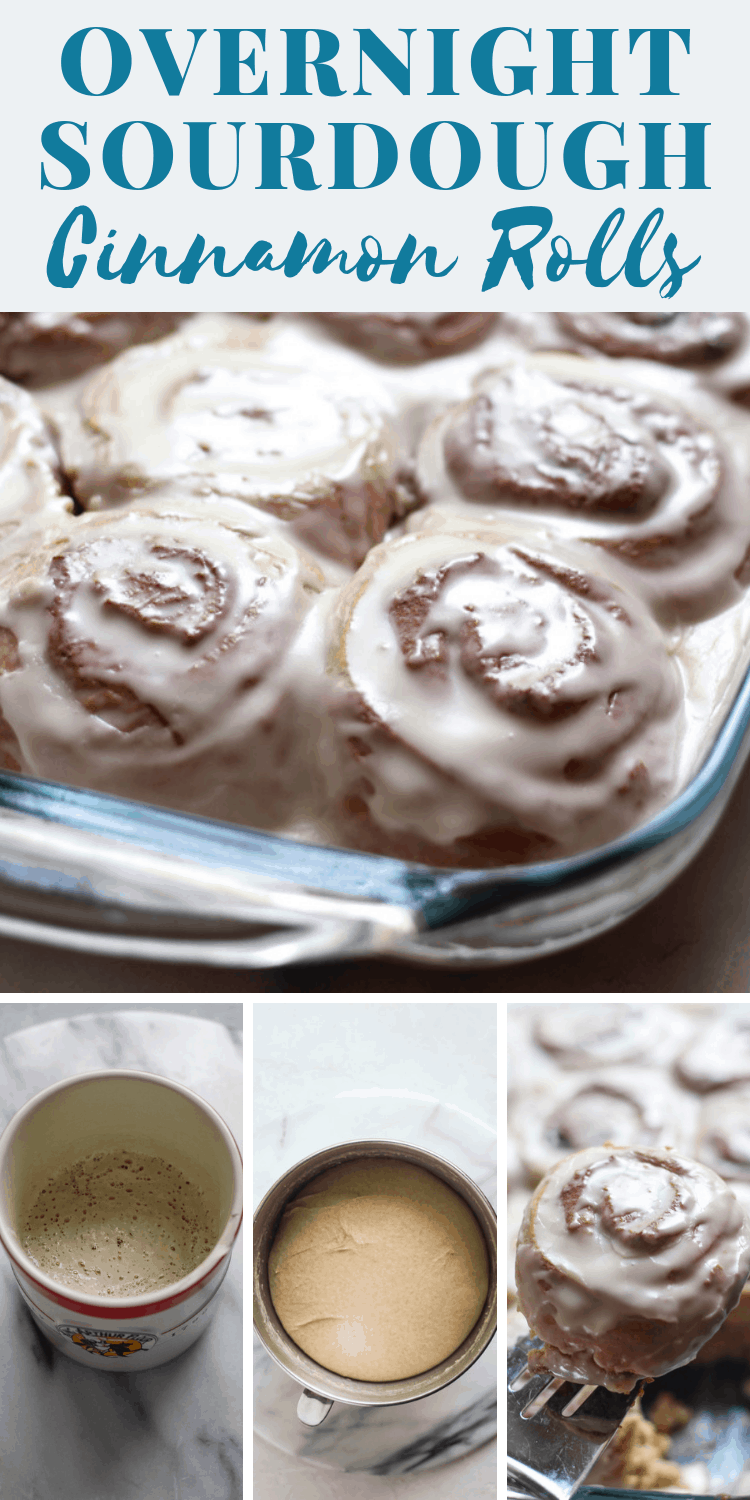

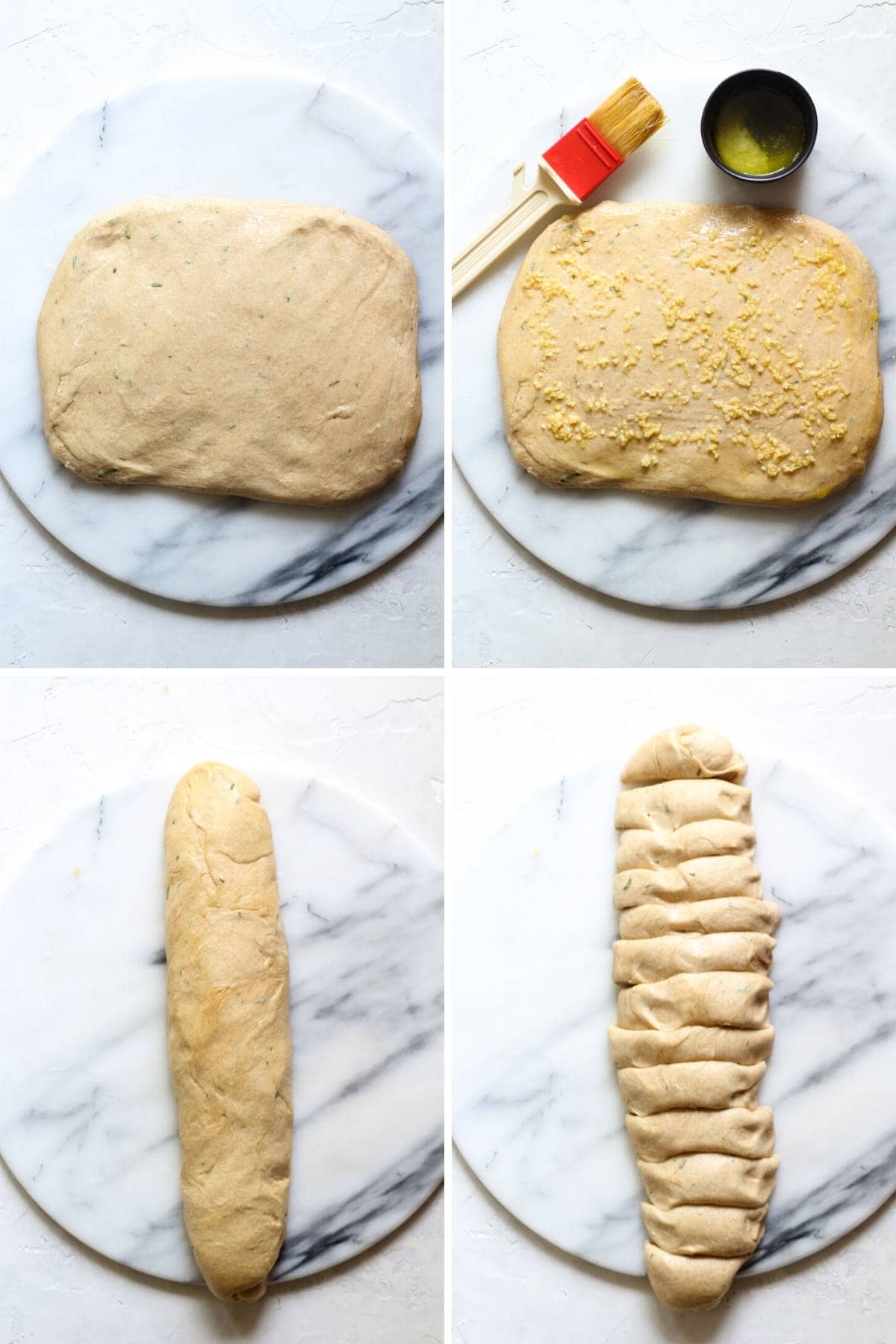
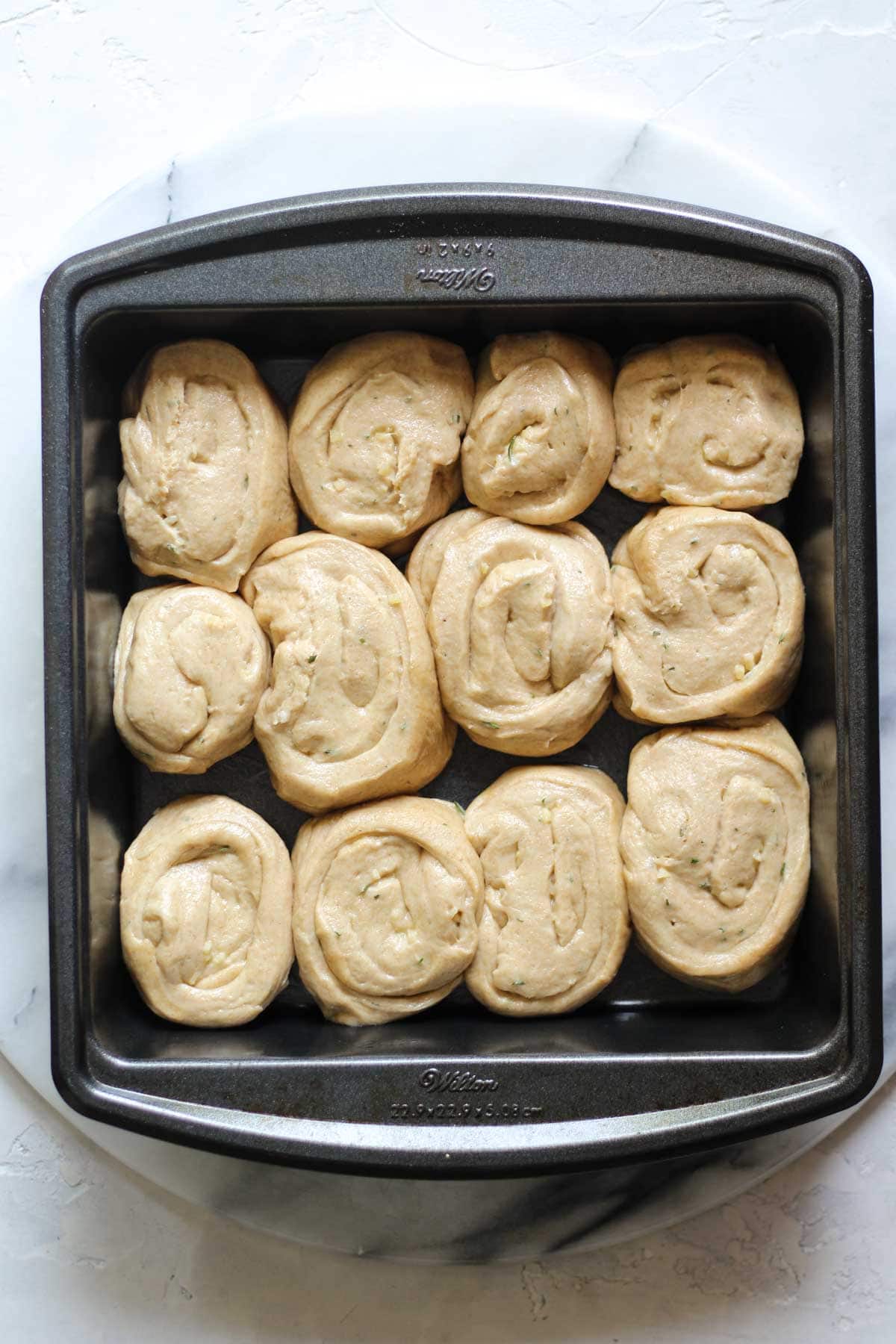
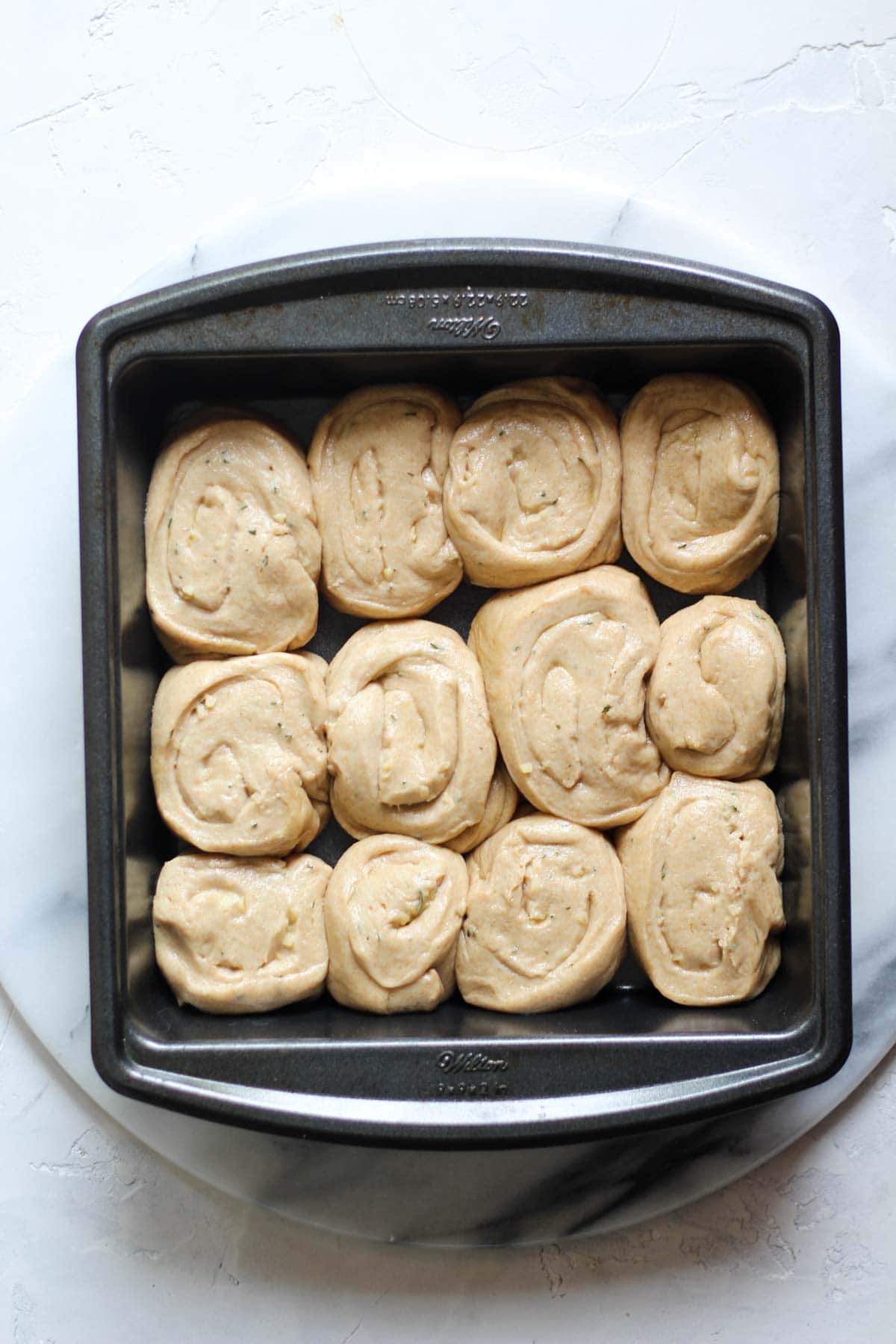
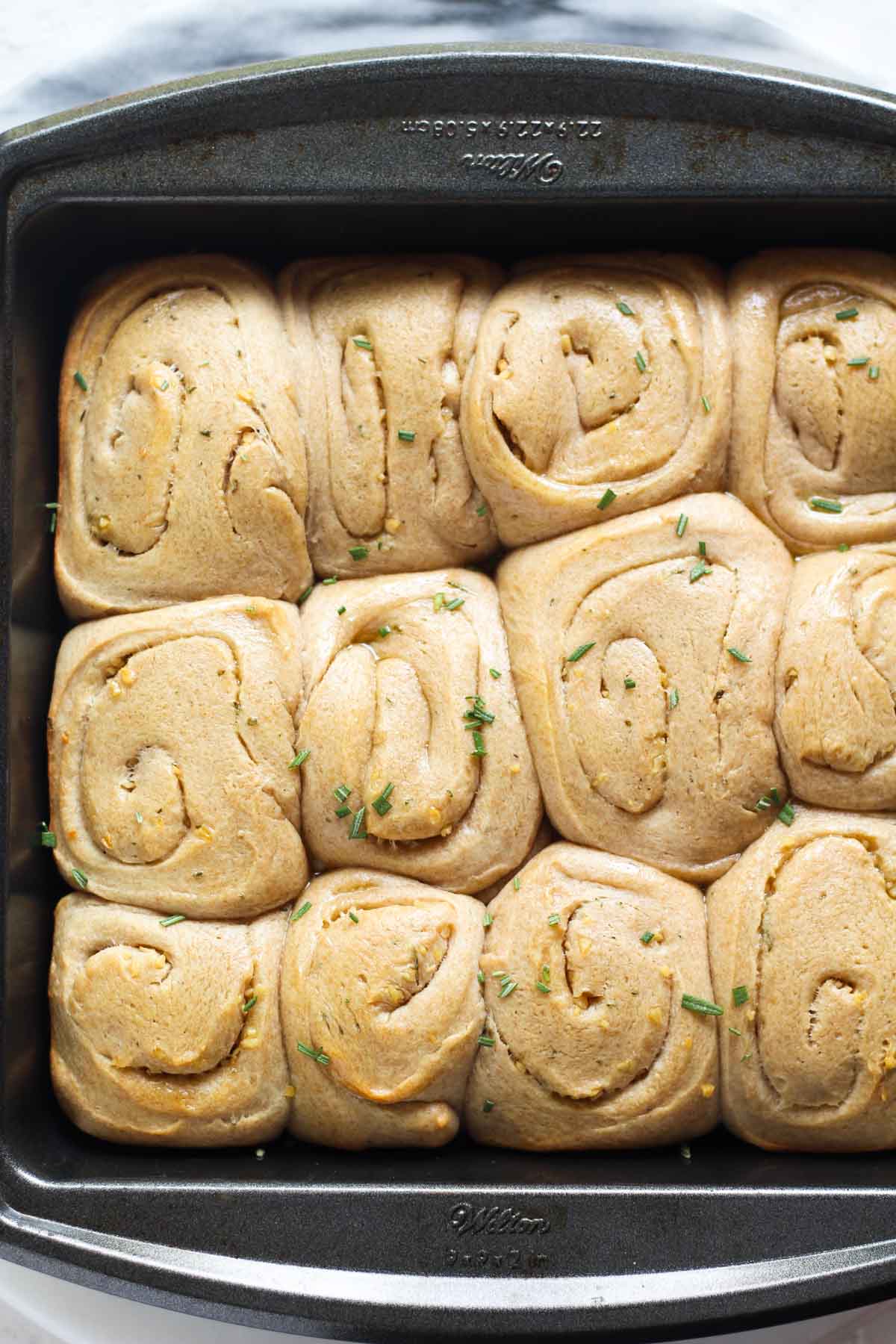
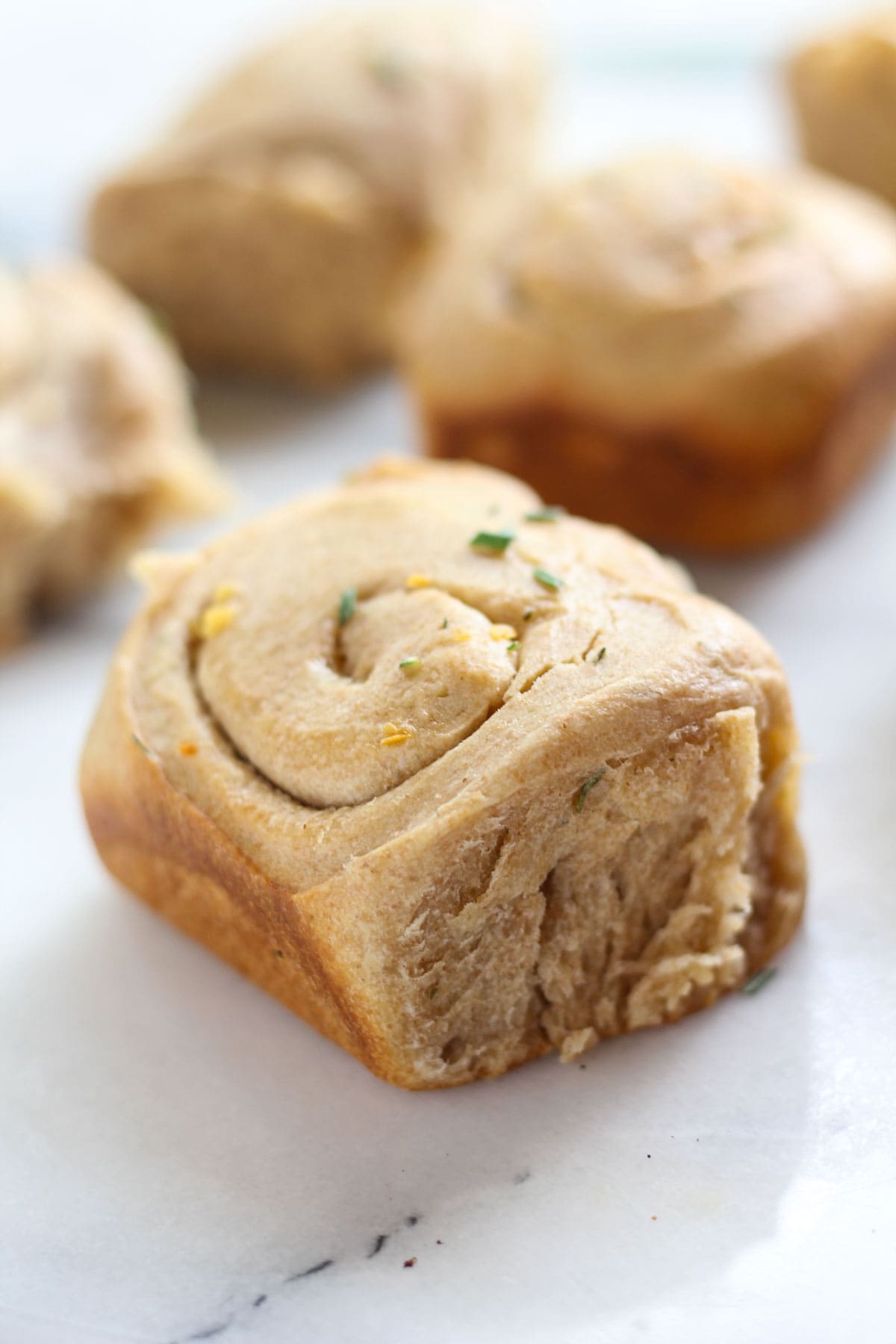
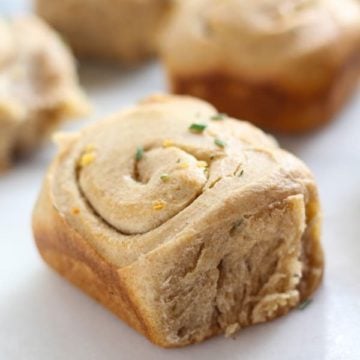
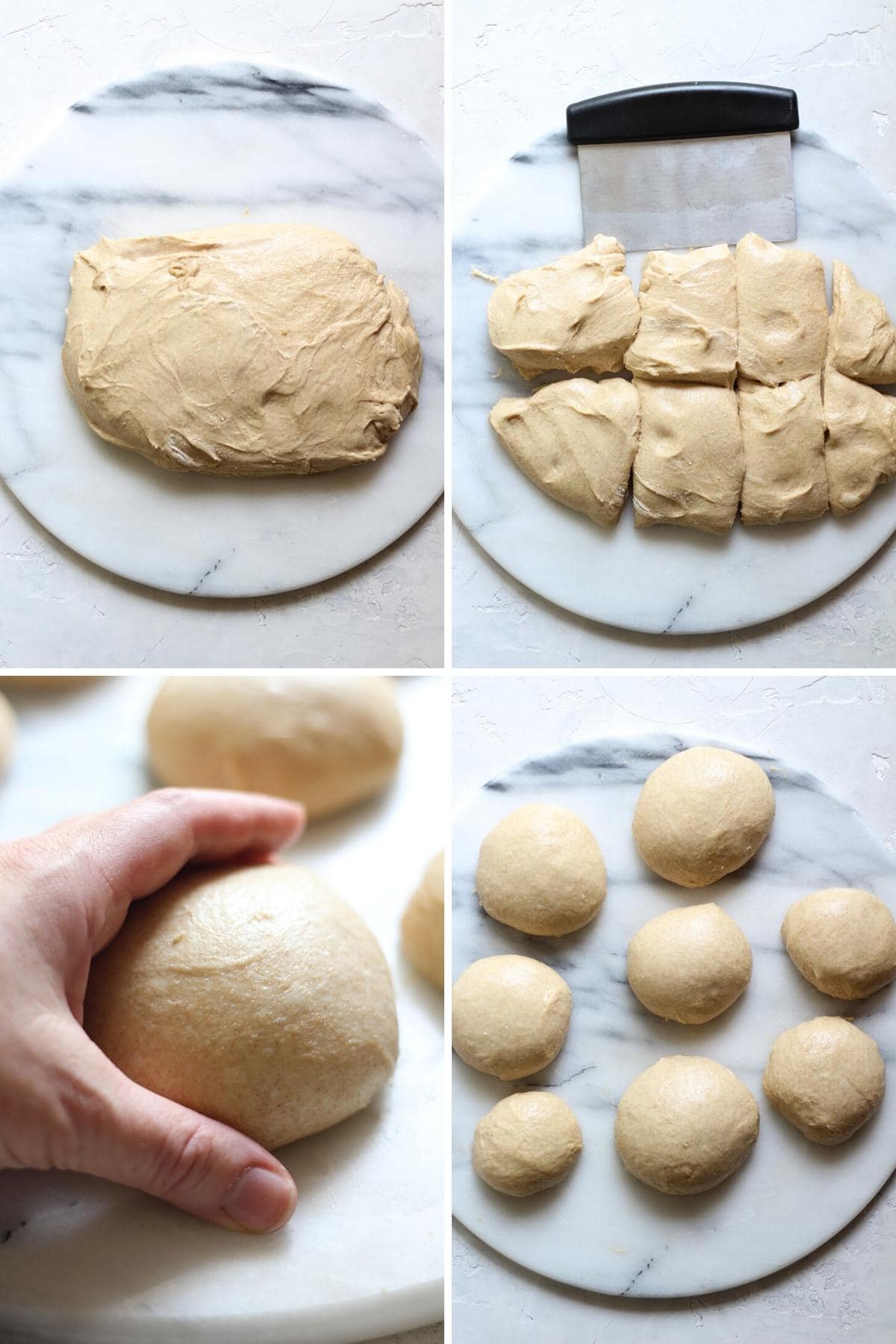
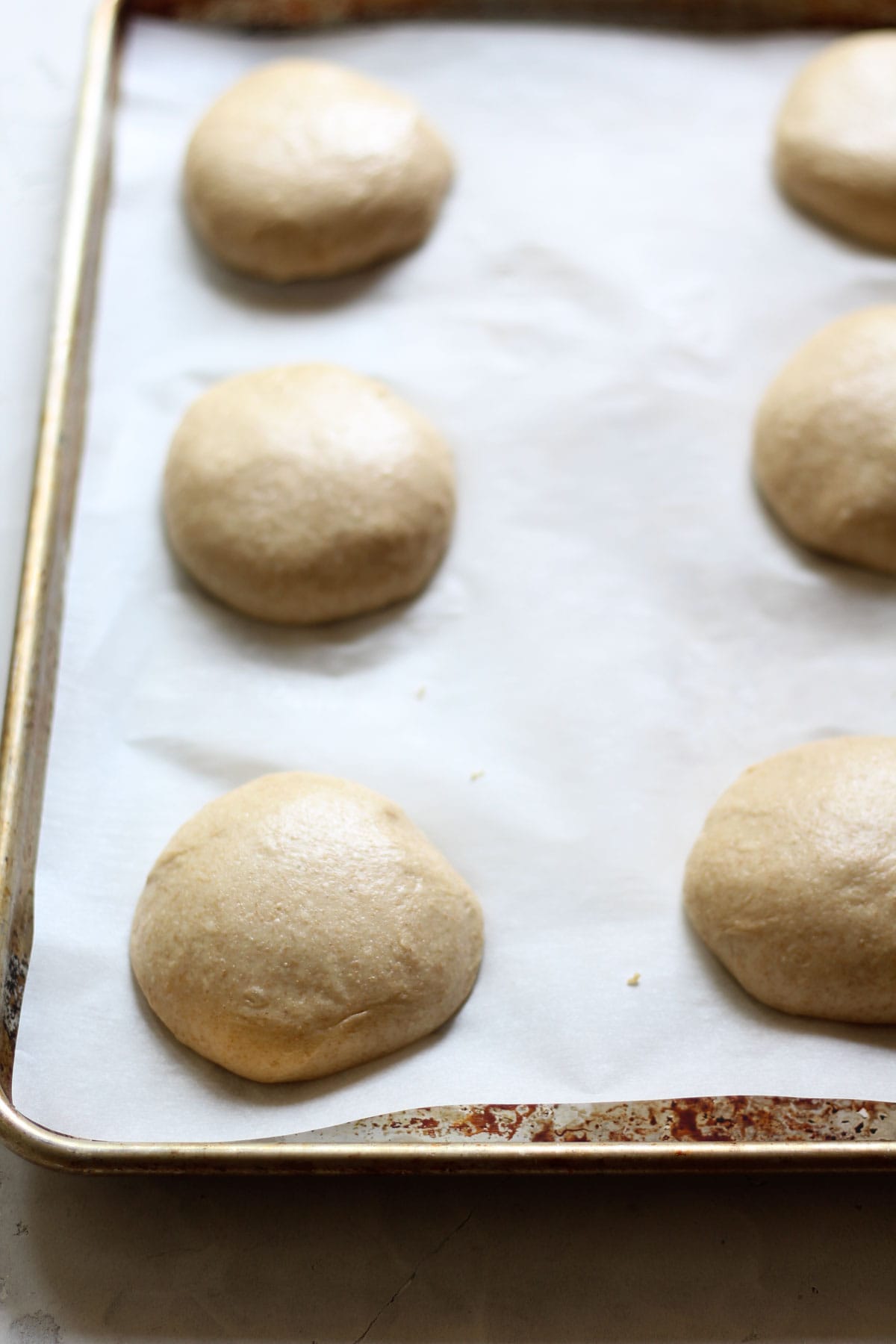
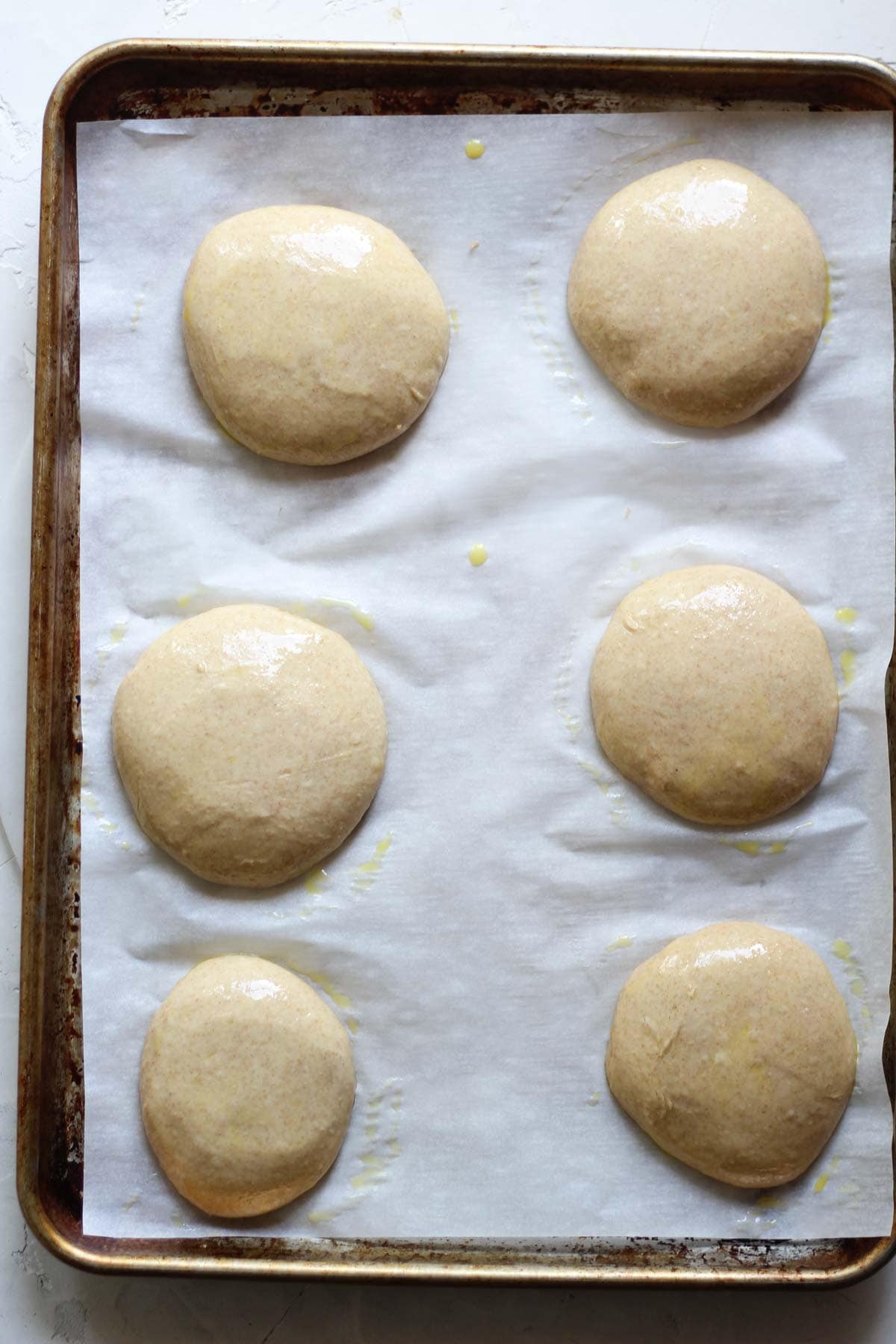
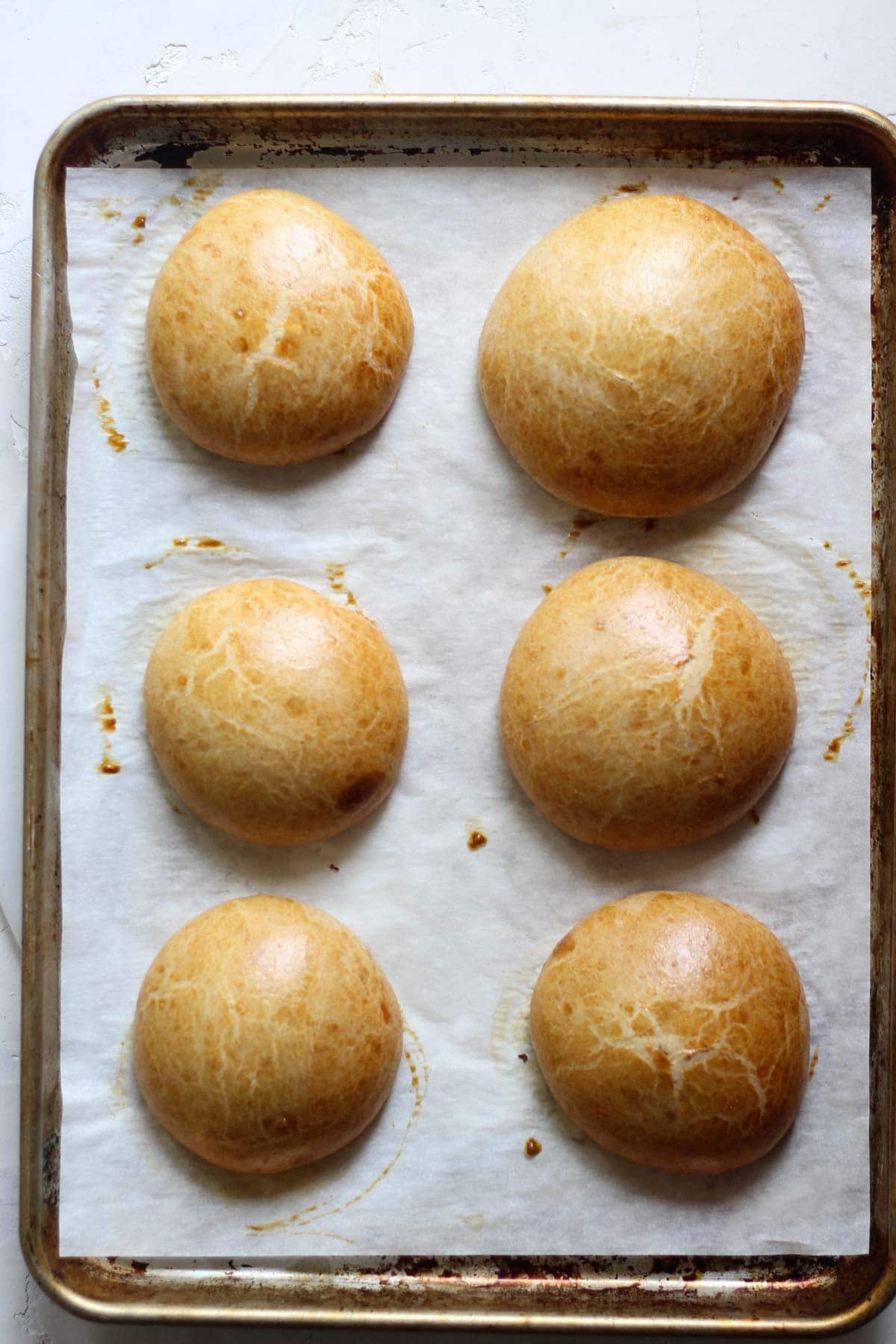
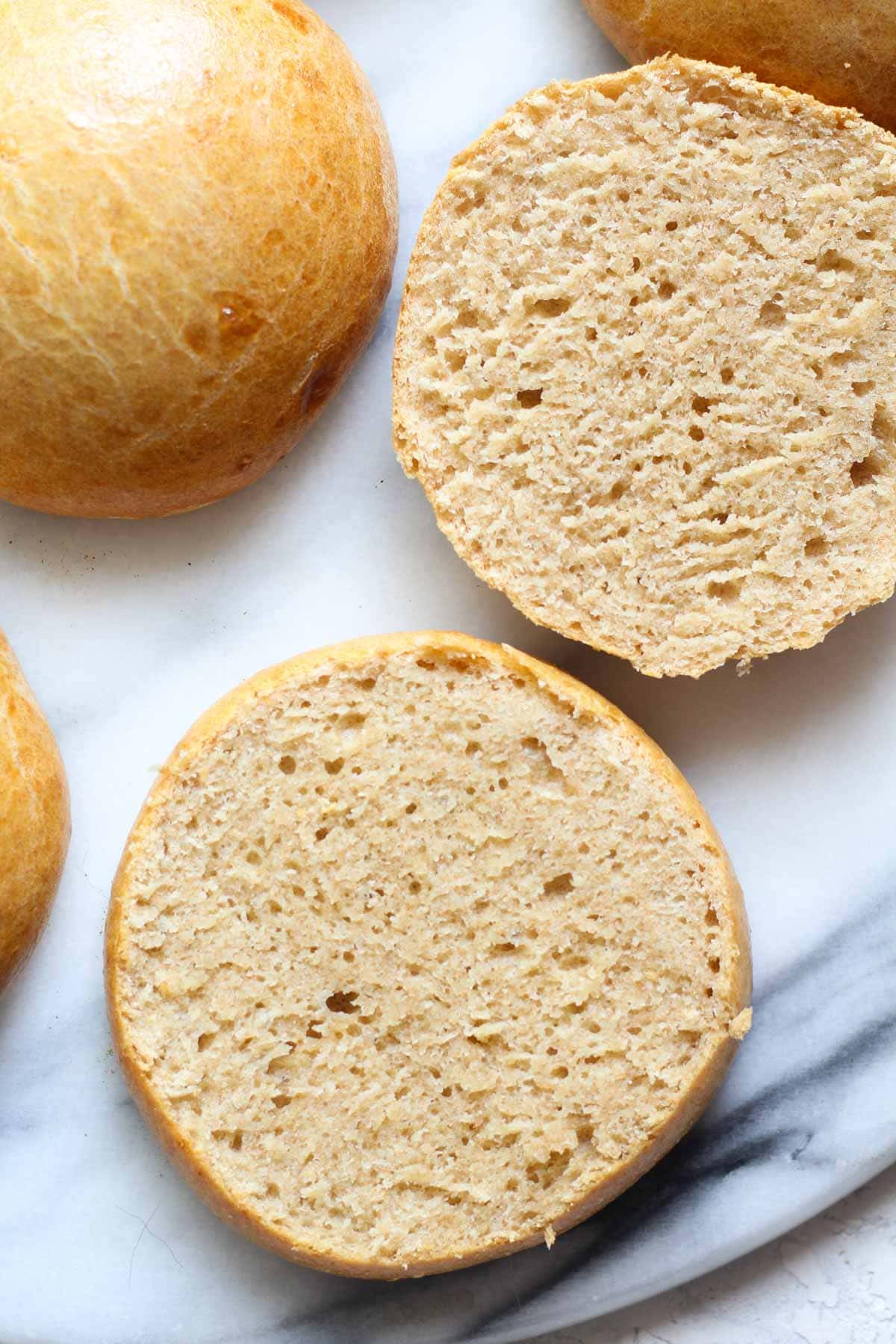
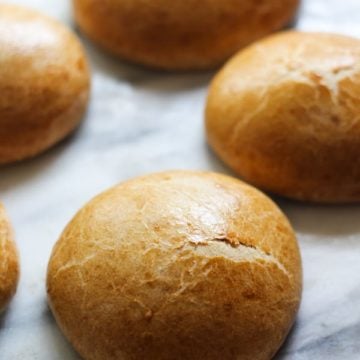
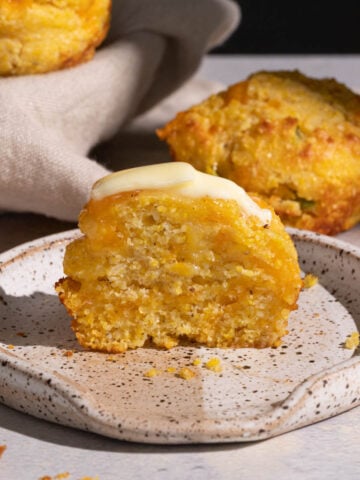


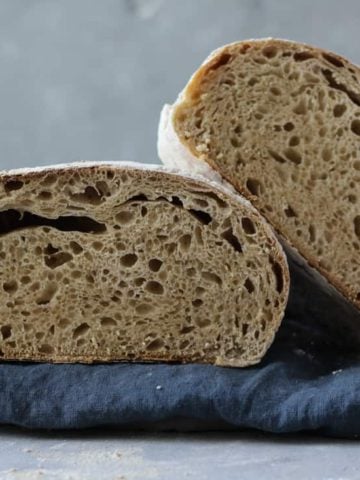
Leslie, this is amazing! I really appreciate all the details and the seperate recipe cards!! i love all the options for using just one recipe. I tried the cinnamon rolls and they were yummy. The whole house smelled delicious! I cant wait to try all of these! I want to make several batches of the cinnamon and rosemary rolls to use during the holidays, will the rolls freeze well? Do I do anything differently to prepare them for the freezer?
Awesome Karen!!!! I’m so glad you made the cinnamon rolls and it’s a great idea to make a few batches of them plus the rosemary rolls for the holidays. You can certainly make both in advance and freeze them. For the cinnamon rolls, I would not add the icing before freezing. Just make sure they are completely cool before wrapping really really well with plastic wrap. When you are ready to bake them, let them thaw on the counter for a while, and reheat in a 250 degree oven until warm. Make the icing, then pour over when they are warm out of the oven.
For the garlic rosemary rolls, you can spread a little melted butter on top after they come out of the oven. Let cool completely, wrap really well in plastic wrap and freeze. To serve, thaw at room temp., reheat in a 250 degree oven until warm, and brush a bit more butter and garlic on top, then serve! Thanks so much for letting me know how the cinnamon rolls turned out.
I love the recipe and the description! Is it possible to make the recipe with just spelt flour so it is gluten free by chance?
Hello Therese, thank you for the question. Just to clarify, spelt is not gluten-free. Spelt is an ancient wheat that hasn’t been hybridized like modern wheat varieties that make up the wheat and white flours you find in grocery stores or in any foods that contain wheat flour.
Many of the problems people have with modern wheat has more to do with the lack of long fermentation that breaks down gluten and a lack of a sourdough culture in their bread and baked goods, plus the awful amount of pesticides sprayed on wheat crops. Many people that feel they are sensitive to gluten find that they do fine with ancient grains such as spelt and kamut. However, if you have Celiacs or are severely allergic to gluten, spelt is not safe to consume.
I go into the problems with modern-day wheat in more depth in my guide “The Case For & Against Gluten, 5 reasons modern-day bread is making you sick…and what you can do about it.” If you subscribe to my blog (there is a form at the bottom of all of my posts) you’ll receive this guide that I think has some helpful information for you.
If you are simply “sensitive” to gluten and feel safe trying spelt flour, you can use the same measurements of whole spelt flour that is in the recipe, but to substitute all-purpose flour, you can use White Spelt Flour which is a refined spelt (spelt without the germ or bran) that will lend a much lighter texture to your bread and baked goods. It’s basically the equivalent of modern wheat all-purpose flour.
If you use only whole grain spelt flour, the dough will be quite a bit heavier and more dense in texture. I don’t really like 100% whole grain breads myself as they have a tendency to be gummy, so I cut that with some white flour.
I did a search on Amazon for White Spelt flour and there were only a few options. Unfortunately, they are all quite expensive. This 5-pound bag is $16.98 (sheesh)! https://amzn.to/2WWMShT
It has lots of reviews so it seems like a good product. Even whole grain spelt is more expensive in stores. I’ve never found any white spelt flour in stores so online is probably your best bet. If you have any other questions, don’t hesitate to ask. I’d love to hear how your brioche turns out, so please come back and check in!
Can’t wait to try them all! Now, can I use sprouted spelt flour?
Yes you can! That’s actually the kind of spelt flour I used for these recipes.
These look awesome! The recipe should work ok with just all purpose flour instead of spelt, yes?
Yes absolutely! Please let me know how they turn out when you make them 🙂
Hello,
Can I leave the dough in the fridge for 3 days if I have to bake them on Wednesday, but only have time to make the dough on Sunday?
Thanks!
I actually just baked these today for Thanksgiving but I freezed the rolls already baked. They preserve well so I know they will taste great. I’ll just thaw them and reheat them on Thanksgiving. You can brush more melted butter on top before you reheat.
You can certainly make the dough, ferment the dough, then punch it down to remove the gases, then cover and keep in the fridge, then bake on Wednesday, but I find completing the process and freezing to be just as effective and they taste great too.
I am not sure if I messed something up or not – does this recipe form a firm ball of dough like sourdough bread does before you put it in the bowl to ferment? I added an extra cup of flour and still didn’t get close to a bread texture, so I just went with it and am letting it ferment… I guess I’ll see in the morning! But was curious as to how your dough looks when you’re done adding all the ingredients and don’t mixing. Thanks!
So this brioche dough requires some kneading with a stand mixer. Did you use a stand mixer with a dough hook? Is the butter absorbed into dough? It should have a a nice gluten structure. It may need some extra kneading. Could you send me a pic via email? I’m bessiebakesblog@gmail.com. I can help you better if I see a pic. If it needs more kneading it’s no problem to do a bit more before fermenting.
Can I just use high protein bread flour
Yes absolutely!
I have made the cinnamon rolls twice and I love this recipe. Quick question, after incorporating the butter, the dough never pulls away from the side of the bowl or achieve the shiny consistency. How long can I continue to run the mixer? I’ve never used the bread hook to knead my bread longer than 12 minutes, as I’m afraid of breaking down the gluten I’m trying to build. Per your recipe:
“Turn the mixer back to 1st speed and add butter to incorporate. Turn back to 2nd speed and mix until the dough pulls away from the side of the bowl and is shiny and elastic.
I’m glad you love the recipe! Because brioche dough is an enriched dough with fat and eggs, those ingredients are what break down the gluten and require more kneading. Brioche dough can sometimes need 10-15 minutes of kneading to develop the gluten. When the dough pulls away from the sides it wraps around the dough hook. If you’ve had trouble getting it to pull away from the sides, I wouldn’t knead any longer than 15 minutes.
Luckily this recipe is a long fermentation recipe and that will help the gluten to continue to develop so that’s probably why the cinnamon rolls have turned out great. Thanks for the question and have a great day!
Since there is dairy products it is okay for the dough to sit over night in room temperature ?
I am new with the sourdough baking dough thing.
Thanks for the question! I don’t recommend letting the dough sit overnight at room temp as it will over-proof and will deflate because of that. You need to slow down the fermentation by placing it in the fridge. This will help it develop flavor too. And yes, because it has dairy products you don’t want it to be sitting out all night at room temp.
For the cinnamon rolls, in the recipe it says to leave at room temp over night I thought? Or do I put it in the fridge overnight?
Ok, my apologies for the confusion! I think I have quarantine brain right now. I had responded to a question above about placing it in the fridge overnight since I often let my brioche doughs ferment in the fridge slowly. But I also will ferment them at room temp (like the recipe is written) so they will get nice and puffy. You can do it both ways. The thing about the fridge is that it’s very cold and will really slow down fermentation, so when you pull it out of the fridge the next morning it may need to ferment at room temp for a little longer. Then you would roll it, butter and fill it, shape it and proof in a warm spot for 60-90 minutes.
These are excellent!! I have made them several times, and each time they are a HUGE hit! Love how easy they are to digest. Thanks for the tasty recipe!
Oh thank you so much for the feedback! I’m so glad the recipe worked well for you. Have a great day!!
Instead of making cinnamon rolls could you twist them into a babka? If so would you change the cook time or temp?
Although I’ve not made babka with this recipe I think it would work! Babka is essentially an enriched dough like brioche, which means it has fat and eggs added. I believe some babka recipes call for a simple syrup glaze on top to give it a sheen. As for the baking time I can’t be for sure but 350 would still be a safe bet temperature wise. However you’ll need to keep an eye on it for the time it needs to bake. I would imagine it would need more than 30 minutes (maybe closer to 45) in the oven, but again, keep an eye on it since I can’t be for certain the time it needs. Please let me know how it turns out if you make this recipe into a babka, I’d love to know!
Thank you for these recipes! I am excited to try them all. I love Spelt and am new to sourdough. I had never made brioche bread before but appreciate the explanation that it includes eggs and butter. What would happen if it didn’t have eggs? Can egg substitutes be used or will that ruin this recipe. Thanks!
Hello Sarah! I’ve never used egg substitutes so I can’t say how it would impact the recipe. Eggs in brioche help to soften the texture and bring richness. I don’t think it would ruin the recipe to use an egg substitute so give it a try!
My dough is not rising! What could I be doing wrong. My sourdough starter is hearty and I make sourdough bread with it frequently. I had fed it 12 hours prior to making the dough and it was triple the size it started and was bubbly. I didn’t have spelt flour but I used king Arthur’s whole wheat and all purpose flour. This is my second attempt at making this dough and I had the same problem last time. Last time I figured out I didn’t knead it long enough but this time I can’t figure it out! Help ❤️. Thanks.
I’m so sorry you had issues with the recipe! If your starter was ripe, it’s likely that the temperature in your house was a bit colder. causing the dough to need more time to ferment. If you fermented it in the fridge, it won’t rise much because the fridge stalls the rising process, so it needs to ferment at a warmer temp after it sits in the fridge overnight. A good place to ferment dough is inside a completely cooled oven with the oven light turned on to make it warmer. However I caution using this method because it’s really easy to forget that your dough is in the oven, then you turn on the oven to heat it up, only to ruin your dough! I’ve done this before by accident myself!
It can be hard to give exact fermentation times because it depends on the temp in the room, the temp of the dough, etc. So you need to ferment longer or shorter depending on how your dough is reacting. I hope this helps and if you have any other questions, I’m happy to try to troubleshoot!
I would love to make these for Thanksgiving morning, but need to prep them two days before due to my schedule. Can I ferment the dough for two days in the fridge? My starter is 1.5 years old and hearty.
If I made the cinnamon rolls in the morning then let them rise all day, then roll them up and such and cut them – can i put those rolls in the fridge overnight before baking in the morning? 🙂
Yes you can definitely do that! I hope you enjoy the cinnamon rolls.